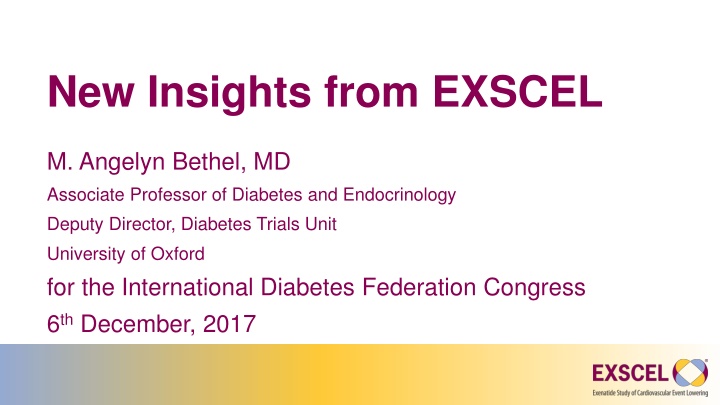
Insights from EXSCEL Study on GLP-1 Receptor Agonist Exenatide in T2DM Patients
Explore new insights from the EXSCEL study, a large international trial investigating the effects of the weekly GLP-1 receptor agonist exenatide on cardiovascular outcomes in patients with type 2 diabetes. Led by academic institutions, the trial aims to assess the safety and efficacy of exenatide in over 14,000 patients with specific inclusion and exclusion criteria. Primary and secondary endpoints include cardiovascular events and hospitalizations, with international enrollment across different regions. This comprehensive study provides valuable data for understanding the impact of exenatide in managing type 2 diabetes.
Download Presentation

Please find below an Image/Link to download the presentation.
The content on the website is provided AS IS for your information and personal use only. It may not be sold, licensed, or shared on other websites without obtaining consent from the author. If you encounter any issues during the download, it is possible that the publisher has removed the file from their server.
You are allowed to download the files provided on this website for personal or commercial use, subject to the condition that they are used lawfully. All files are the property of their respective owners.
The content on the website is provided AS IS for your information and personal use only. It may not be sold, licensed, or shared on other websites without obtaining consent from the author.
E N D
Presentation Transcript
New Insights from EXSCEL M. Angelyn Bethel, MD Associate Professor of Diabetes and Endocrinology Deputy Director, Diabetes Trials Unit University of Oxford for the International Diabetes Federation Congress 6thDecember, 2017
EXSCEL Large, pragmatic, international trial designed to characterise the effects of once weekly GLP-1 receptor agonist, exenatide, on CV- related outcomes in patients with T2DM, when added to usual diabetes care Double-blind, placebo-controlled trial randomising participants to exenatide 2 mg once weekly injection or matching placebo Academically led by the Diabetes Trials Unit, University of Oxford and the Duke Clinical Research Institute in collaboration with industry sponsorship
EXSCEL: Study design EXENATIDE ONCE WEEKLY ~14,000 Patients Safety Follow-up (70-days) PLACEBO ONCE WEEKLY 1w 2m 6m 1y Visits every 6 months Randomisation (double blind) End of Treatment Minimum 1360 primary events Aim is for glycaemic equipoise Key Inclusion Criteria T2DM, HbA1c 6.5-10% (inclusive) Anti-DM drug na ve, oral agents and/or insulin 18 years old Any level of CV risk ~70% with prior CV event Prior coronary, cerebrovascular or peripheral vascular event or stenosis Key Exclusion Criteria T1DM 2 episodes of severe hypoglycaemia within 12 months Current or prior GLP1-RA eGFR <30mL/min/1.73m2 Prior pancreatitis Personal or familial history of MEN-2 Baseline calcitonin >40ng/L
Primary and secondary endpoints Time to first occurrence of 3-point MACE composed of: CV death Non-fatal MI Non-fatal stroke Safety hypothesis (non-inferiority) and efficacy hypothesis (superiority) Primary Endpoint Time to first occurrence of: 1) All-cause mortality 2) CV-related death 3) Fatal or non-fatal MI 4) Fatal or non-fatal stroke 5) Hospitalisation for acute coronary syndrome (ACS) 6) Hospitalisation for heart failure (HF) Secondary Endpoints
International enrolment North America n=3708 (25%) 190 sites Europe n=6788 (46%) 329 sites Latin America n=2727 (18%) 64 sites Asia Pacific n=1529 (10%) 104 sites Total Randomised = 14752 Mentz RJ, et al. Am Heart J, 2017; 187: 1-9
Baseline characteristics Exenatide n=7356 62.0 (56.0, 68.0) Placebo n=7396 62.0 (56.0, 68.0) Characteristic Age (years) Female 2794 (38.0) 2809 (38.0) White 5554 (75.5) 5621 (76.0) Body Mass Index (kg/m2) 31.8 (28.2, 36.2) 31.7 (28.2, 36.1) eGFR (mL/min/1.73 m2)* 76.6 (61.3, 92.0) 76.0 (61.0, 92.0) Duration of diabetes (years) 12.0 (7.0, 17.0) 12.0 (7.0, 18.0) HbA1c (%) 8.0 (7.3, 8.9) 8.0 (7.3, 8.9) History of congestive heart failure 1161 (15.8%) 1228 (16.6%) Values are median (IQR) for continuous variables or n / N (%) for categorical variables. Percentages presented are for available data. *MDRD formula used to calculate eGFR. Site-reported values are presented.
Participant follow-up and study medication duration Exenatide n=7356 Placebo n=7396 Study Duration Median (IQR), years 3.3 (2.3, 4.4) 3.2 (2.2, 4.3) Premature Study Medication Discontinuation* 43% 45% Study Medication Duration Median (IQR), years 2.4 (1.4, 3.8) 2.3 (1.2, 3.6) Proportion of Time on Study Medication Mean (SD) 75 35% 76 35% * Site-reported premature permanent discontinuation of study medication
Average differences in CV risk factors during follow-up LS Mean Difference (95% CI) p-value HbA1c (%) -0.53 (-0.57, -0.50) <0.001 Weight (kg) -1.27 (-1.40, -1.13) <0.001 Systolic Blood Pressure (mmHg) -1.57 (-1.92, -1.21) <0.001 Diastolic Blood Pressure (mmHg) +0.25 (0.04, 0.47) 0.020 Heart Rate (bpm) +2.51 (2.28, 2.74) <0.001
No differences in prespecified safety outcomes SAEs & treatment emergent SAEs Severe hypoglycaemia Pancreatitis Charter defined malignancy Specifically, no differences in pancreatic or medullary thyroid cancer
Primary composite: MACE-3 (CV death, nonfatal MI, nonfatal stroke) Intention-to-Treat Analysis for Non-inferiority & Superiority HR (95% CI) 0.91 (0.83, 1.00) P value (non-inferiority) <.001 P value (superiority) 0.061
Primary composite cardiovascular outcome components Exenatide N=7356 Placebo N=7396 Hazard Ratio 95% CI P value <.001 839 (11.4%) 905 (12.2%) (non-inferiority) 0.061 (superiority) MACE 0.91 0.83, 1.00 3.7 per 100 pt-yrs 4.0 per 100 pt-yrs 258 (3.5%) 229 (3.1%) 0.88 0.73, 1.05 CV-death 0.628 455 (6.2%) 470 (6.4%) (homogeneity among components) 0.84, 1.09 0.95 Non-fatal MI 177 (2.4%) 155 (2.1%) Non-fatal stroke 0.86 0.70, 1.07 0 0.5 1 1.5 2 Exenatide favoured Placebo favoured
Secondary endpoints Exenatide N=7356 Placebo N=7396 Hazard Ratio 95% CI P value 584 (7.9%) 507 (6.9%) All-cause mortality 0.86 0.77, 0.97 0.016 340 (4.6%) 383 (5.2%) 0.76, 1.02 CV-death 0.88 0.096 483 (6.6%) 493 (6.7%) Fatal or non-fatal MI 0.97 0.85, 1.10 0.622 187 (2.5%) 218 (2.9%) 0.70, 1.03 0.095 Fatal or non-fatal stroke 0.85 602 (8.2%) 570 (7.7%) 1.05 0.94, 1.18 0.402 Hospitalisation for ACS 219 (3.0%) 231 (3.1%) 0.94 0.78, 1.13 0.485 Hospitalisation for heart failure 0 0.5 1 1.5 2 Placebo favoured Exenatide favoured
Completed GLP-1 Receptor Agonist Cardiovascular Outcome Trials Drug exposure time (y) Primary End point Key inclusion criteria A1C , % Median follow-up duration (y) 1.9 Lixisenatide (1) MACE-4 (non-inferiority) 5.5- 11.0 ACS within 180 days 30y R 2.1 Placebo 2.0 N=6068 Liraglutide 3.5 50y with CVD/renal dysfunction/HF, or 60y with CV RFs (2) MACE-3 (non-inferiority) 3.8 R 7.0 7.0 Placebo 3.5 N=9340 1.8 Semaglutide MACE-3 (non-inferiority) (3) SUSTAIN-6 N=3297 50y with CVD, or 60y with subclinical CVD 2.1 R 7.0 7.0 1.9 Placebo Exenatide 2.4 MACE-3 (non-inferiority for safety/ superiority for efficacy) Established CVD as well as primary prevention (70/30 split), 18y 6.5- 10.0 R 3.2 Placebo 2.3 N=14752 0 1 2 4 3 Median Follow-up Duration (years) 1 Pfeffer MA et al. N Engl J Med 2015; 373: 2247 2257 2 Marso SP et al. N Engl J Med 2016; 375: 311 322 3 Marso SP et al. N Engl J Med 2016; 375: 1834 1844
Meta-analysis: MACE-3 endpoint Bethel et al. TLDE 2017; in press
Meta-analysis: All-cause mortality Bethel et al. TLDE 2017; in press
Meta-analysis: CV mortality Bethel et al. TLDE 2017; in press
Meta-analysis: Other CV outcomes Neutral impact of GLP-1 RA treatment Endpoint HR (95% CI) p-value Fatal and nonfatal myocardial infarction 0.94 (0.86, 1.03) 0.18 Fatal and nonfatal stroke 0.87 (0.75, 1.00) 0.052 Heart failure hospitalization 0.93 (0.83, 1.04) 0.20 Unstable angina hospitalization 1.09 (0.90, 1.32) 0.39
Meta-analysis: Safety Endpoints Severe Hypoglycaemia OR 0.93 (95% CI 0.74, 1.18), p=0.56 Pancreatitis OR 0.90 (95% CI 0.63, 1.28), p=0.54 Pancreatic Cancer OR 0.83 (95% CI 0.33, 2.11), p=0.70 Bethel et al. TLDE 2017; in press
Summary: main trial results EXSCEL met its primary safety hypothesis MACE-3 HR 0.91 (0.83, 1.00), p<0.001 for non-inferiority EXSCEL did not meet its primary efficacy hypothesis MACE-3 HR 0.91 (0.83, 1.00), p=0.061 for superiority Secondary outcomes were consistent with the primary outcome All-Cause Mortality: HR 0.86 (95% CI 0.77, 0.97), p=0.016 Cardiovascular Death: HR 0.88 (95% CI 0.76, 1.02), p=0.096 Hospitalisation for Heart Failure: HR 0.94 (95% CI 0.78, 1.13), p=0.485 No imbalance in key safety endpoints Severe hypoglycemia, pancreatitis, malignancy
Summary: GLP-1 RA class effects Overall, the EXSCEL cardiovascular and mortality findings were consistent with those seen with other GLP-1 receptor agonists in the ELIXA, LEADER and SUSTAIN 6 trials further, supporting the use of these agents for the treatment of type 2 diabetes For the class, there were significant reductions in MACE-3 CV mortality All cause mortality No differences in Hypoglycaemia Pancreatitis Pancreatic cancer A favourable risk- benefit balance
Available online at the close of this presentation: DOI: 10.1016/S2213- 8587(17)30412.6


